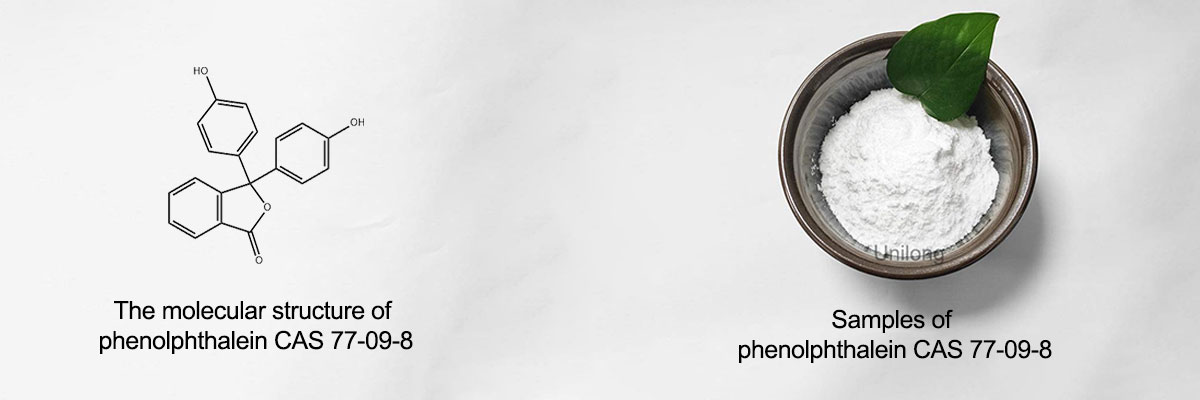Phenolphthalein CAS 77-09-8, as a low-key substance in the field of chemistry, plays an indispensable role in many areas. It is an organic compound with the chemical formula C20H14O4. Visually, it is a white or slightly yellowish crystalline powder. The density of Phenolphthalein is 1.277g/cm³ and its melting point is around 262.5°C. It is readily soluble in alcohol. Slightly soluble in ether. Slightly soluble in dimethyl sulfoxide, insoluble in benzene or hexane. Because it is insoluble in water, when preparing Phenolphthalein indicator, we usually dissolve it in ethanol to make Phenolphthalein CAS 77-09-8 ethanol solution, which can be conveniently used in various chemical experiments.

In acidic and neutral solution environments, Phenolphthalein always remains colorless, low-key and unassuming. However, when it encounters an alkaline solution, the solution instantly turns purplish red, which is very eye-catching. This magical color-changing property makes Phenolphthalein an indispensable indicator in acid-base titration experiments.
The reason why Phenolphthalein CAS 77-09-8 can have such a wonderful color-changing performance lies behind strict chemical principles. Phenolphthalein is a weak organic acid, and in solution, there exists a balance between molecular and ionic states. In acidic solutions, the concentration of H⁺ is relatively high, and Phenolphthalein mainly exists in the form of colorless lactone. When the solution is alkaline, the concentration of OH⁻ increases, and the Phenolphthalein molecules undergo structural changes, transforming into a quinone structure. This structure can absorb light of specific wavelengths, thus giving the solution a purple-red color.

In addition to its acid-base indicator properties, Phenolphthalein can also undergo chemical reactions with other substances. When Phenolphthalein comes into contact with strong oxidants such as hydrogen peroxide and potassium permanganate, due to the oxidation effect of the strong oxidants, the molecular structure of Phenolphthalein will be destroyed, thus losing its color-developing function. In addition, in some organic synthesis reactions, Phenolphthalein can also be used as a reaction reagent to participate in specific chemical reactions. Under specific conditions, such as high temperature or light exposure, Phenolphthalein may undergo structural changes, resulting in color variations.
Phenolphthalein has other applications besides its use in chemistry:
Phenolphthalein was once widely used as a laxative in the medical field, mainly for treating habitual and intractable constipation. The principle of its action is that Phenolphthalein is not absorbed in the intestinal tract after oral administration. Under the action of the alkaline intestinal fluid in the small intestine, it slowly decomposes to form soluble sodium salts. These sodium salts can stimulate the nerve plexus within the intestinal wall, directly act on the intestinal smooth muscle, increase intestinal peristalsis, and promote the excretion of feces.
In the industrial field, Phenolphthalein plays a significant role in plastic synthesis, especially in the synthesis of diazazanaphthone polyaryletherone polyaryletherone polymers. In the process of synthesizing such high-performance polymers, Phenolphthalein participates in the reaction as a key monomer. The specific structure in Phenolphthalein molecules can form covalent bonds with other monomers through chemical reactions, thereby constructing the macromolecular chain structure of the polymer. This kind of diazazanaphthalone polyaryletherone polyaryletherone polymer synthesized with Phenolphthalein has many excellent properties. They have excellent heat resistance and can maintain stable physical and chemical properties in high-temperature environments, without easily decomposing or deforming. This makes them have broad application prospects in some industrial fields with high heat resistance requirements, such as aerospace and electronic appliances.
In the textile printing and dyeing industry, Phenolphthalein can be used as an acid-base indicator to monitor the pH of the dyeing solution during the printing and dyeing process. The pH value of the dyeing solution has a significant impact on the dye uptake rate, color light and dyeing quality of the fabric. By using Phenolphthalein indicator, operators can promptly understand the changes in the pH value of the dyeing solution, so as to adjust the formula and process parameters of the dyeing solution and ensure the stability and consistency of the dyeing effect.
The demand for Phenolphthalein in industries such as pharmaceuticals and chemicals is driven by multiple factors. In the pharmaceutical industry, although the use of Phenolphthalein as a laxative is restricted, research in other pharmaceutical applications has been making continuous progress, which has driven the demand for Phenolphthalein. With the enhancement of environmental awareness, Phenolphthalein, as a green and environmentally friendly organic synthesis intermediate, has gradually attracted attention in the production of dyes and fluorescent agents. Its synthesis process is relatively environmentally friendly, and different color expressions can be achieved by adjusting the structure, which has great application potential. This has further promoted the market demand for Phenolphthalein.

Unilong pays great attention to the environmental impact of its synthetic raw materials and reaction by-products during the production of Phenolphthalein. Through strict processing, it ensures the quality of Phenolphthalein while achieving environmentally friendly treatment. There is currently stock available for convenient transportation. If you would like to know more, please leave your contact information and our 7* 24-hour business manager will get in touch with you promptly.